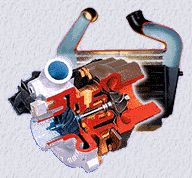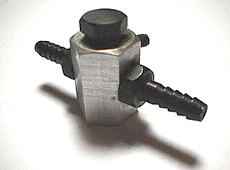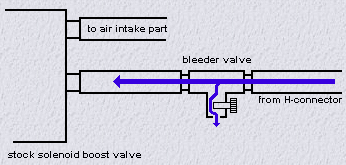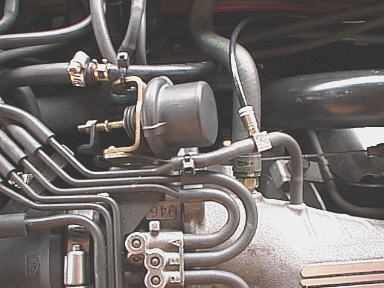
New York - Munich - Portland - San Francisco - Seattle - Stockholm - Vancouver - Zurich
International HQ: 273 Fifth Avenue, NYC 10016

New York - Munich - Portland - San Francisco - Seattle - Stockholm - Vancouver - Zurich
International HQ: 273 Fifth Avenue, NYC 10016
Typical setups / diagrams / pictures
A Turbo Primer by Roger Gerl

![]()
|
This page shows some "good to know" fundamentals about our great cars. My aim is to have this page grow more and more due to YOUR input. Maybe it will become something like a FAQ about basic things like vacuum tubing, wastegates, blow-off valves, etc. It should be informative and helpful for the turbo-rookies, or for anyone interested in the basic principles. |
![]()
How the Turbo / Intercooler stuff works
|
The drawing below (from the Garrett pages) shows the typical Turbo / Intercooler live-circle. Please note that there are no fuel parts necessary to understand the principle. |
|
|
|
So, how does the thing work ? 1. The engine's cylinder exhaust gases
travel out of the exhaust valves to the Turbo. Why do we need an Intercooler ? Each engine has an optimal temperature operating range. As our different ambients can vary sooo much, the engine computers also measure barometric pressure, air temperature and amount of air the engine sucks in. With this the optimal amout if air/fuel ratio for the current ambient is determined and the engine runs in its parameters. Fact: The more heat the engine is getting, the less power is produced. For design purposes it is also desirable to minimize the variable "intake temperature" as much as possible. But we learned that compressing the air produces heat ! And the more the air is compressed the more heat is produced. Therefore somebody had the idea to cool down the compressed air ... the Intercooler was born. With this element the air is cooled down to acceptable temperatures and allows us freaks to increase the boost without the danger of losing the needed horses. Of course, cooling the engine always helps to keep it alive longer. What the &%ç is a wastegate ? Its name says all.... a gate that is able to waste something away :-) Physics tells us that the faster the turbine wheel turns, the faster the compressor wheel turns, and therefore the more air will be transported. Also the compression increases due to the speed. Of course, this depends on the style of the compressor wheel, housing and whatever as the boost and rpm curve are not linear together. But this will be dicussed sometime later :-) The wastegate now is a device that can control the boost by releasing (wasting) some amount of the exhaust gases to the exhaust BEFORE traveling to the Turbine Wheel. Therefore, the Compressor Wheels are not driven that fast, and boost is reduced. The wastegate is opened by an actuator, driven by air pressure. The actuator is preloaded with a spring and opens the wastegate when the pressure applied exceeds the spring's load. Usually the Compressor's output will be connected by a vacuum hose to the wastegate-actuator. Therefore, the bigger the boost of the compressor, the more the wastegate opens and the less boost will be produced. But less boost means closing the wastegate more, and therefore, more boost will be produced. To get more control for opening and closing the wastegates, the 3000GT/Stealth have a solenoid valve that, activated by the ECU, relieves some of the boost out of the hose that runs to the wastegate actuators. This circle regulates the boost our car needs to go that faaaaast :-) This is the basic functionality for getting more boost. |
|
|
|
The bleeder valve, or, "How do I fool the system" ? |
|
This is the easiest and cheapest modification to a Turbo-driven engine. For only a few $, you can get about 20% more power out of your beast ! This section shows why it works and also, how dangerous it can be! OK... From the previous section, we know how a wastegate acts. Check out the picture below. At the y-pipe from the intercoolers (the black plastic ellbow that goes into the throttle body) a vacuum hose is attached right at the ellbow (marked red). This hose is running to a hose distributor called H-connector. At this point, the pressure is distributed to the front and rear wastegates as well to a stock solenoid valve. This valve helps the stock system to increase boost by releasing some of the pressure in this hose connection into the intake part. This means, if the solenoid valve is open, pressure to the wastegate actuators will be lowered and the wastegates will stay closed, or even will be activated later. If the solenoid closes the valve, the full pressure from the y-pipe goes to the actuators and, if pressure becomes more than the load of the actuator's spring, the wastegate opens and less boost will be produced. |
|
|
|
Now we know that the stock system controls the wastegates somewhat consevatively and the maximum boost is about 8 to 12 psi maximum that can be achieved. But if you look at the drawing there must become something in mind. What will happen if I drop the pressure in the actuator lines compared to the pressure in the y-pipe? You're right, the actuators will be activated later as boost rises. Therefore, if we are able to release about 2 psi of boost, we will have an advantage now of 2 psi, and we will have gained that amount of boost ! On our cars, this modification is easy, ..... but dangerous as well: If the vacuum lines for the wastegate leak and stay at atmospheric level, the wastegates would never open and you're car would run like hell around 20-30psi. But this would not last for long as it would kill your engine for sure :-( |
|
It can be done with the help of a cheap aquarium valve that acts as a Bleeder Valve. In my setup I did 2 years ago, I used a professional bleeder valve with a locking screw. It's very good quality and withstands high temperatures. Also it cannot readjust itself :-) |

|
|
Here you see how this bleeder valve MUST WORK ! The blue arrow should show the pressure in the line. A part of it is then bled to nowhere (or just the ambient) to reduce the overall pressure in the line. Note, with only this kind of bleeder and at this position, the best performance can be achieved. This because the stock solenoid still controls the boost by the solenoid valve. If you do a different setup, then you'll always lose low-end power. |
 |
| Where do I place the bleeder
valve ?
First, check out the modified picture below. Here you can see that the valve is placed just before the stock solenoid valve. This is because it's so easy to reach and can be removed within seconds :-) Please note that you have to locate the hose coming up from the H-connector ! This is the right hose, as the ones at the stock solenoid could be exchanged. |
|
|
Also note the aftermarket boost meter we need ! You must have it, since the stock unit is inaccurate, too slow, and doesn't show enough on it's scale. A definite MUST for tuning in your new system!. |
To connect the gauge, simply cut the line that comes from the upper part of the intake manifold in the middle and use a T-piece to connect the additional hose that runs to the meter. The hose can then go through the firewall (under the steering column) in to the cabin. Do this before you install the bleeder valve and go for a run to see if your readings are fine and you don't have any vacuum leaks. With the stock setting you should see about 6 - 10psi, depending on the year and health of your car. |
 |
Now locate the hose that goes into the stock solenoid valve. If you have an additional hose just pull it from the stock piece and plug it to the one side of the bleeder valve. Now use another piece of hose, connect it to the other side of the bleeder valve and plug the other end to the stock solenoid valve. Secure both side of the bleeder valve with small clamp or wire ties. Voilà, that's it. Finally check for any vacuum leak as this is the evil for any failures. |
Picture not yet available |
| How do I adjust the bleeder valve
?
First, close the valve as much as
possible and then just open it a little. Drive the car savely and watch
the boost meter. On our cars, the most boost will be produced in 3rd gear
from 3500rpm till about 5700rpm. Of course it depends on your mods, age
and more. So just drive your car in 2nd, hammer it through this band, and go
into 3rd around 5000rpm. Rpm will drop to about 4000rpms and boost will rise
very quickly. Always keep an eye on the gauge and do not exceed any boost
over 15psi. If your car makes less than 14psi, open the valve a little
bit more and secure the screw. Do this again and again until you're at
14psi peak. Of course, close it more if you overboost !!
|
Since the 1st generation were limited to 8psi, these cars will gain a lot ! My european 3000GT TT made 284hp stock and we peaked up to 352hp with just this mod. This was in winter time and after we checked it again in summer time we got about 334hp. After readjusting the valve we were back at around 345 horses. The bleeder valve cannot work like a
boost controller. This because it's a passive thing and it cannot toggle
the valve to wave-up the boost or to limit it. Therefore it was only a
temporary mod while I saved the money, and just waited until the boost controllers
became reachable for my wallet. Read the next section about the boost
controller setup. I highly recommend a boost controller rather than the
bleeder valve ! |
![]()
Typical boost controller setup in our cars
The following drawing shows the turbo-system of the 3000GT/Stealth TwinTurbo cars with a typical boost-controller attached. Of course, my drawing is not complete in all details, but contains the parts that are needed to understand how the system works. Remember the described stock
solenoid valve? It relieves some of the boost that goes to the wastegate
actuators, and therefore keeps them closed longer - as they would if the the
boost at the actuators were the same as in the intake. Also remember the
bleeder valve-- with its help we kept the wastegates closed even longer.
But all these setups do not allow us to control the wastegates optimally. So
the best thing is to add an intelligent Boost Controller to your car's
turbo system. |
|
|
As described earlier, less pressure to the wastegate actuators than their springs' load keeps the wastegates closed. For this, the boost controllers use their own valve to reduce the pressure that goes to the actuators. The picture shows the typical setup. The source for the boost pressure is the hose connected to the elbow of the intercooler Y-pipe that combines the two intercooler pipes and goes into the Throttle body. This hose is now connected directly to the IN port of the solenoid valve of the BC. The OUT port of the box will then be conntected to the front and rear wastegate actuators. Please note, that no bleeder valve nor the stock solenoid valve is needed because the BC does its job perfectly with its own valves. To keep the drawing as realistic as possible, I left the H-connector in place and only capped the one hose that went to the stock solenoid valve. Also, the valve's input was capped. A big note : Always check for any vacuum leaks as this is the "evil source" of all problems... and NEVER overboost! :-) Have fun ! |
![]()
![]()
![]()

Article and All Turbo Images © 2000-2004 Roger Gerl, All Rights Reserved.
All Other Images © 1995-2004 Bob Forrest, All Rights Reserved.